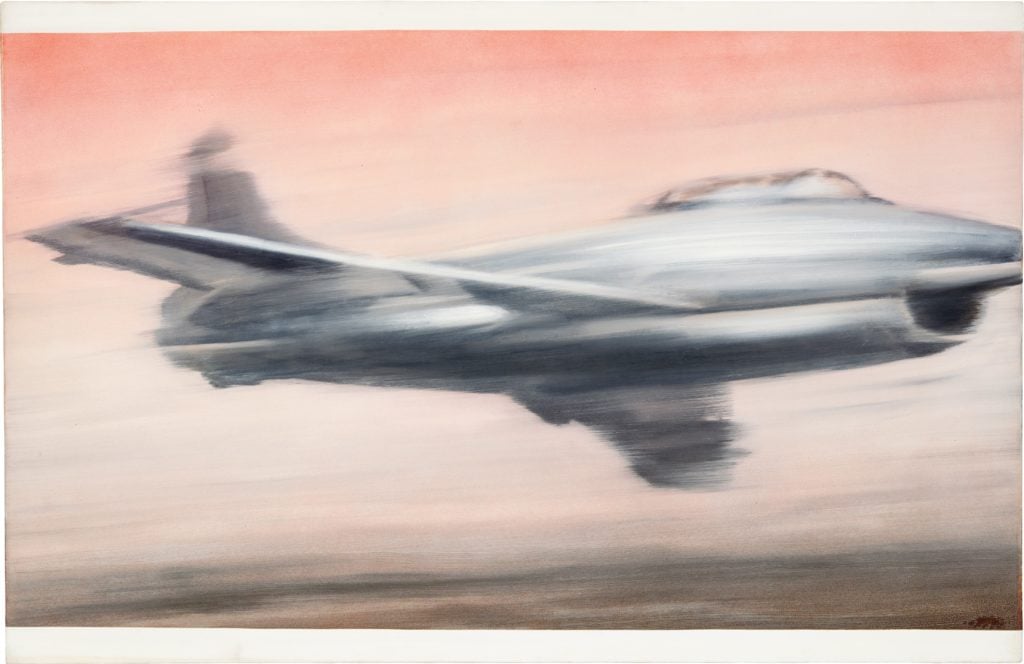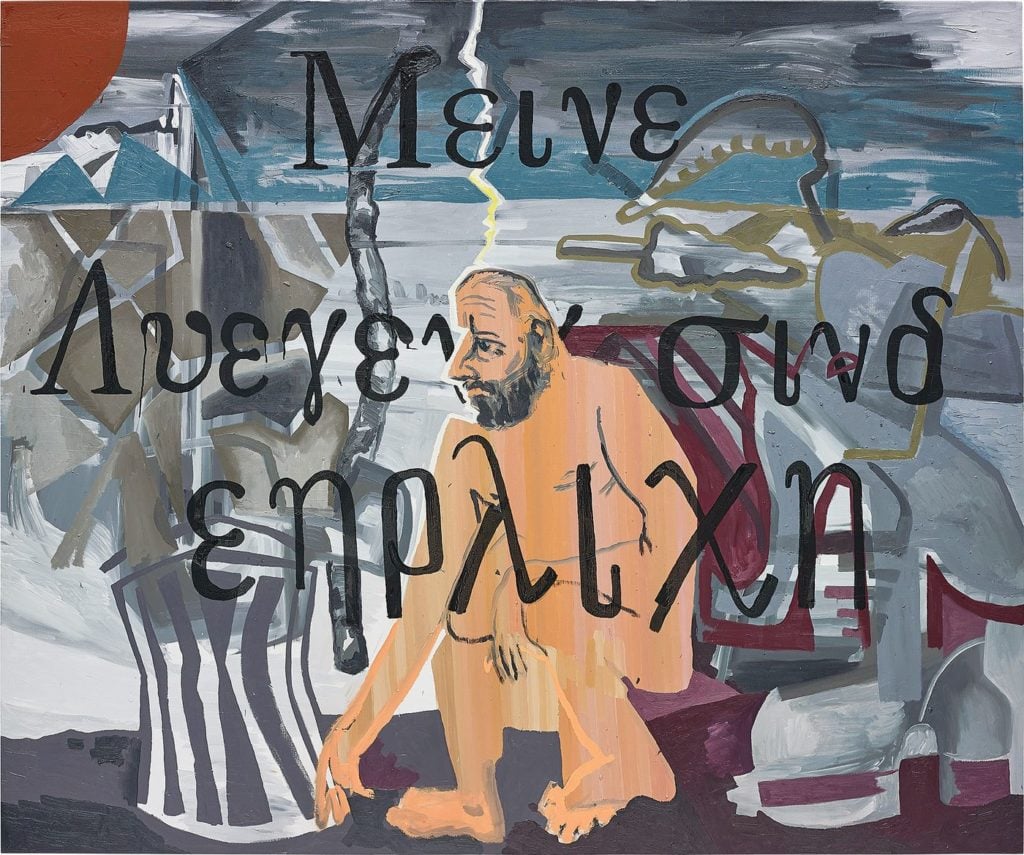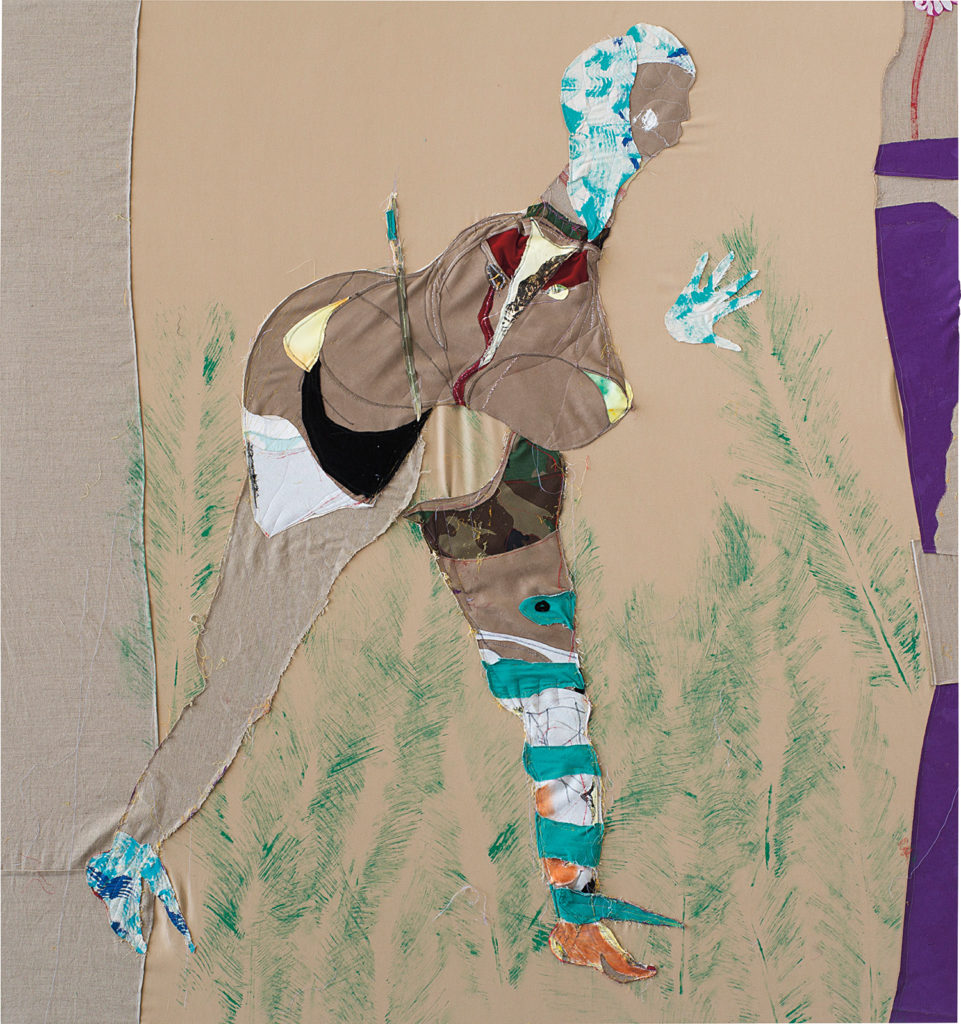Auctions
Gerhard Richter’s Jet Fighter Lands in Phillips’s Respectable $48 Million Sale in London, But Bullish Bidding Is Hard to Find
Phillips capped off a somewhat difficult week at the auctions in London.

Phillips capped off a somewhat difficult week at the auctions in London.

Colin Gleadell

Phillips brought up the rear of this season’s slimmed-down London Modern and contemporary art auctions with a 29-lot sale this evening that brought in a respectable £36.4 million ($47.7 million), towards the higher end of the house’s total estimate of £27.3–38.8 million ($35.7–50.8 million). Only three lots went unsold.
But the numbers stand in stark contrast to last year. In 2018, Phillips ran a triumphant 50-lot sale that drew £97.8 million ($135 million), the highest-ever total for any Phillips sale anywhere. That auction was led by a Picasso portrait of Marie-Therese Walter that sold for £41.8 million ($57.8 million), which alone was more than the total of this year’s sale. (Prices include premiums; estimates do not). There were no such trophies this time around, and the top Modern work—a Magritte gouache estimated at £900,000–1.2 million ($1.2–1.3 million)—was withdrawn from the sale.
The remaining top lot shouldn’t really have been there. Gerhard Richter’s 1963 photo painting, Jet Fighter, had a £10–15 million estimate ($13.1–19.6 million) and a long backstory. In 2016, it was offered by Phillips in New York with a third party guarantee and a $25–35 million estimate. With little competition on the sales floor, the picture sold to the guarantor, a then-unidentified buyer. When he defaulted payment, Phillips took him to court, revealing him to be Chinese businessman Zhang Chan. Phillips, having paid out the price to the seller minus any commission, was left stuck with the picture. It hoped to recoup its losses ($24 million) in tonight’s sale.
Before opening the lot, the auction house took the precaution of announcing that only bidders who had registered with a “premium gold” card could bid—an unprecedented move in a UK auction, but one that is normal in Hong Kong, where payment insurance is required on high-value lots. (Chinese auction-house bidders do not, apparently, carry the same degree of responsibility for paying after they have won lots they do in the West.)
While its history had been slightly tarnished, Jet Fighter attracted several bidders before selling to Phillips deputy chairman Robert Manley, who was on the phone with the winner of the £15.5 million ($20.3 million) painting. Although that might seem to add up to a loss for Phillips, chairman and chief executive Ed Dolman told artnet News that there was still some unfinished business with the client that would see them clear the deficit.

Martin Kippenberger, Ohne Titel (Meine Lügen sind ehrliche) (1992). Courtesy of Phillips.
A work by Richter’s countryman, Martin Kippenberger, came up next. His eccentric 1992 self-portrait, Ohne Titel (Meine Lügen sind ehrlich), has passed through seven collections in the past 18 years, during which time its price has increased 15-fold. In November 2001, it sold at auction for $247,750, and returned to public sale in 2014, when it was bought below its low estimate for £2.3 million ($3 million) at Sotheby’s London by Indonesian billionaire Budi Tek for his Yuz Museum in Shanghai. Tonight, Tek’s painting (although Phillips billed it simply as “the property of an important collector”) had an estimate of £3.5–4.5 million ($4.6–5.9 million). It sold to a client, presumably the guarantor, of Phillips chair Cheyenne Westphal for £3.8 million ($5 million).
Elsewhere tonight, there were more reasonable returns on investments. A 1996 ceramic pot by Grayson Perry, purchased in 2007 for £50,000, sold to London dealer Offer Waterman for £120,000 ($157,000). And earlier in the evening, a typical painting by market darling KAWS doubled its 2017 auction price, selling—albeit just above the low estimate and probably to the guarantor—for £805,000 ($1 million).
But two records that opened the sale probably bettered even those impressive returns. A seven-foot collage on canvas, Lilith (2015), by 29-year-old American artist Tschabalala Self, was the artist’s first work at auction and came after a sell-out display with her dealer, Thierry Goldberg, at Art Basel Miami Beach this winter. Little wonder, then, that the £40,000–60,000 ($52,000–79,000) estimate was more than doubled when it sold £125,000 ($164,000), setting a benchmark for the young artist.
Another artist, not so young (in her 80s, in fact), is eccentric British artist Rose Wylie, who was recently signed by David Zwirner. In the wake of her much-publicized London exhibition, her previously non-existent auction market established a benchmark of £106,500 ($139,000) at a Sotheby’s day sale yesterday. This evening, it rose to £175,000 ($229,000) for a riotously informal, 11-foot diptych, Queen of Sheba with a Gold Lump (2015).

Tshabalala Self, Lilith (2015). Courtesy of Phillips.
Also going strong was Armed and Fearless (2014), a medium-size painting by Cecily Brown, which was bought from Gagosian Gallery while she still exhibited with him. The sale of the work tonight capped a strong week for her market, and attracted multiple phone bids from the US. In the end, it went (without a guarantee) for £1.8 million ($2.4 million), double its estimate. Later in the evening, a 2009 digitally concocted unique and colorful Photoshop print by Cory Arcangel, which saw bidding in the room and on the phone, sold to an Asian phone bidder for £300,000 ($393,000), also doubling its estimate.
After all that, the failures were hard to remember. A Lucio Fontana ceramic plate that looked as if it had been slashed by the artist sold for £112,500 ($147,000), well below its estimate of £120,000–180,000 ($157,000–236,000). The only unsold works were a burned black painting on paper (a conservator’s nightmare) by Alberto Burri; a circular butterfly painting by Damien Hirst; and a semi-pornographic George Condo painting, Monk at the Brothel, which had sold in 2013 for $266,550, before his market had completely taken off. The buyer was now looking to double that, but may have misjudged the market. It didn’t elicit a single bid.